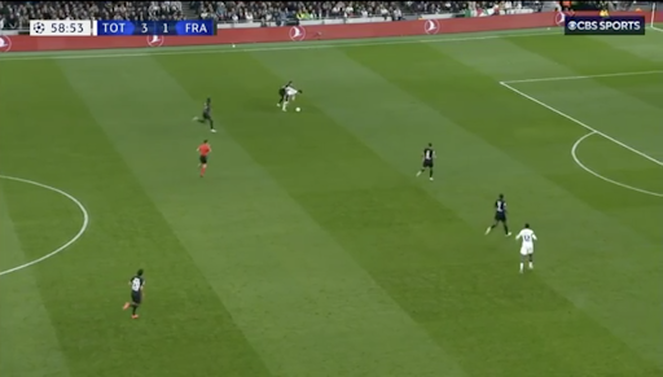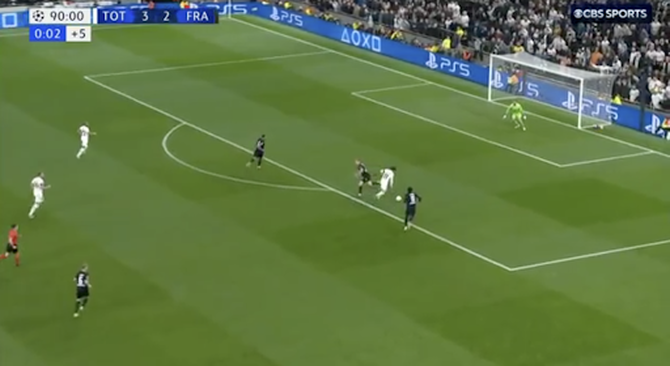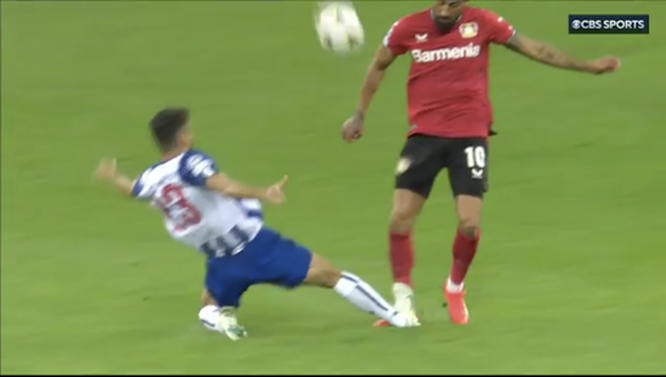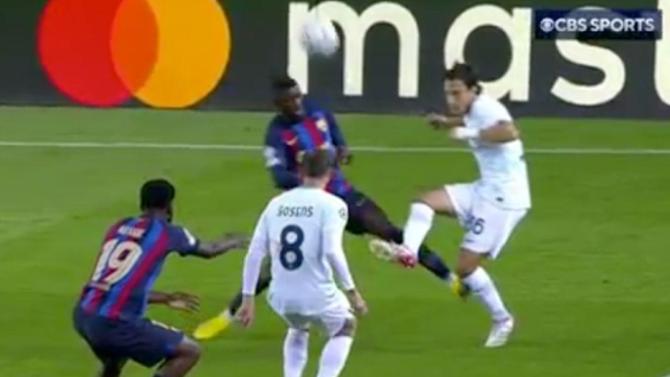Champions League refereeing controversy: Why Fikayo Tomori shouldn’t have seen red against Chelsea, and more
Written by ABC Audio All Rights Reserved on October 15, 2022
The football world is calling the 17th minute red card to Milan’s Fikayo Tomori for denying obvious goal scoring opportunity (DOGSO) and subsequent penalty a travesty, lamenting the injustice of the call. Cries of the “game’s is gone,” ringing out from fans. But, the real crux of the issue is not whether the punishment fit the crime, but rather whether there was a crime at all. What the debate should be is whether the upper arm body contact that occurred is in itself a foul because everything depends on how its answered. There is no way withing the rules to advocate for a penalty and yellow card, that can’t occur, so the question is was the incident a foul at all. Let’s take a look at the call and the rest of the major decisions from the Champions League Matchday 4 (you can catch all the Champions League action on Paramount+).
Fikayo Tomori’s red card for DOGSO
Here’s the play:
Going to the law, any DOGSO infraction that occurred by holding, pulling or pushing has always been a penalty and red card. That was true even before a recent change to the law was implemented. Before the 2016-17 season the International Footballing Association Board, the organization responsible for the rules, made a very notable law change altering sending off offenses inside the penalty area for DOGSO to avoid what was considered a “triple-punishment”. Before the change, a player who committed a DOGSO offense in the penalty area was automatically red-carded, was handed a one game suspension, as well as giving away a penalty.
The law change was modified to the following:
“Where a player commits an offense against an opponent within their own penalty areas which denis an opponent an obvious goal-scoring opportunity and the referee awards a penalty kick, the offender is cautioned if the offense was an attempt to play the ball; in all other circumstances (e.g. holding, pulling, pushing, no possibility to play the ball etc.) the offending player must be sent off.”
That modified DOGSO in the penalty area to be yellow card only if there is an attempt to play the ball. Officials are asked to liberally apply “attempt tp play the ball” in application. However, DOGSO red card for triple-punishment was purposely kept for plays that where not clear attempts to play the ball but purely tactical and not football actions.
The law is clear in this situation, if the referee determines (1) a foul has been committed in the penalty area, (2) that it satisfied the requirements to be a denying obvious goal scoring opportunity, and (3) the foul was not an “attempt to play the ball” then the offending player must be sent off.
Given the way the rule is written, the debate truly is whether a foul occurred in the first place by Tomori against Mount. Is there actual physical contact by the arm on Mount? Yes. Does this level of contact rise to a foul that warrants a penalty and red card in the context of this play? The answer here is no. Both players are battling for not only possession, but also for spatial advantage when initially getting to the ball. There is no other defender who can intervene in the play aside from the goalkeeper once Tomori is beaten, but when you don’t slow down the play and take still shots but rather watch it at full speed, you can see Mount fights through the contact and makes a solid attempt at getting to the ball before the keeper is able to block it. This kind of play, at this speed, and at this level, is a common, expected level of football in terms of physical contact meaning that officials frequently would not call this an infraction.
Is there debate to be had on this play? Yes! It’s clearly a borderline situation, which is another reason why it is not appropriate for VAR to recommend it down for a penalty or for overturn of a penalty. It is not a clear and obvious error. In fact, I can fully appreciate the referee in real time believing there is enough physical contact and holding by Tomori to call it a foul, penalty and red card but on review, ironically best angles are the ones from goal line which the referee would never have a view of, and those are the ones that confirm the contact is just not enough leading to the preferred decision of no foul in the first place. However, Tomori does take a risk by extending his arm not only once but twice and as a result the decision can go either way. So the call itself is a close one but it’s important to remember that if it is a foul, it also must be penalty, red card and one game suspension.
The Final Decision: No foul but also no VAR recommendation to overturn the penalty kick and red card.
Another DOGSO decision from Tottenham vs. Frankfurt
While we are playing in DOGSO world, a brief refresher on the four considerations of when a foul rises to a denying obvious goal scoring opportunity (DOGSO). In a previous column on DOGSO, we looked at how referee’s must account for four considerations at the moment the foul occurs to come to the right decision:
- Distance between the offense and the goal.
- General direction of the play.
- Likelihood of keeping or gaining control of the ball.
- Location and number of defenders.
Take the four DOGSO considerations and we have two really good examples to work through from MD4 that occurred in the Tottenahm Hotspur v. Eintracht Frankfurt.
In the 59th minute a Frankfurt defender, Tuta, commits a holding offense against Tottenham’s Heung-Min Son after Son once again burns him on the dribble. Tuta was issued a yellow card for stopping a promising attack, but since it was his second yellow card (he had just received one against Son only five minutes before for a tactical foul after Son beat him), he was issued a red as well and dismissed from the game.
Given that the result was a red either way, practically it didn’t impact the match but the talking point here is why this wasn’t a direct red card for DOGSO since it felt like Tuta was the last defender and Son would have been heading towards goal unopposed. Using the four criteria needed to convert the stoping a promising attack into a DOGSO (and since the infraction occurred outside the penalty area it could only be a red card if determined DOGSO) you will see one of the criteria’s is clearly not met – location and number of defenders and because of that, officials will punish for only stoping a promising attack which is a yellow card offense only.
It is critical to note that the moment you determine whether an infraction is a DOGSO is the moment the actual foul occurs. I like to look at it like taking a “snapshot” of the moment from both the center referee viewpoint and the assistant referee viewpoint and with each piece of the puzzle in mind it is then important for the officials to communicate to get these decisions correct. Typically, the center official has direction of play and distance to goal and the assistant referee helps with the location and number of defenders because of their advantageous position to look across the line and see where everyone is at the time the foul occurs. Both officials can assist one another when it comes to likelihood of keeping or gaining control of the ball, and the assistant referee’s communication becomes even more important when there is a heavy touch and center referee cannot by angle appreciate whether the player can get to the ball before the goalkeeper.
This is the snapshot at the time Tuta commits the foul against Son. As you can see we have two more defenders who are located near and “behind” the ball in the sense they can reasonably defend that ball if Son had not been fouled. So we only have stopping a promising attack and a (second) yellow card for Tuta.
Here is the snapshot for the 90th minute foul in the same game as Frankfurt’s Hrvoje Smolcic extends a leg to prevent the attacker from getting to the ball. At time of the snapshot we see everything we need. 1. At the time the foul is committed, there are no other defenders who can reasonably defend the ball before the attacker strikes on goal, aside from the keeper. 2. The ball is very close to the goal. 3. The direction is direct although slightly to the right of the goal, not enough to substantively affect direction of a top level attacker from getting a shot off. 4. Attacker has full possession on the dribble, it is not a heavy touch where the likelihood of getting to the ball is outweighed because the keeper will get there first. And, importantly, it is in the penalty area and since officials are advised to liberally apply “attempt to play the ball” we would consider this an attempt (even though the ball is past) and admonish it with a yellow card and penalty for DOGSO.
Deliberate handling offense by Manchester City’s Riyad Mahrez
In the 11th minute of Manchester City’s match against Copenhagen we see a beautiful strike by City’s Rodri hit the back of the net, only for it to result with an accepted VAR recommendation to disqualify the beautiful goal because of a deliberate handling offense by City’s Riyad Mahrez in the attacking phase of play (“APP”) before the goal was scored.
Im not sure if the football world finds this is controversial because they don’t believe it is deliberate handling or just because they are upset to see a beauty taken back by the correct decision, but sadly this one is pretty clear
Final Decision: VAR Recommendation is correct to disqualify the goal for deliberate handling.
There is no denying it touched the hand of Mahrez, and as I explained in the column after Matchday 1, this is not an infraction of “accidental handling by an attacker” leading up to the goal by a teammate (which was eliminated from the laws in 2021-22). As a general rule of thumb (pun intended), not every contact to the hand is handling but Mahrez’s is is for the following reasons:
- Mahrez is watching the ball the entire time and is aware that the ball is about to land in front of him
- Mahrez does not make any attempt to move his arm “away” from the ball but instead keeps it outstretched in front of him and softens the drop of the ball.
- In not removing his arm but allowing it to “cradle” and bring the ball down, he gains control of it completely with his arm/hand.
In the context of this play, and taking into account the football principle that “football expects players to be penalized for handling if they gain possession/control from the ball and gain a major advantage (score goal or goal scoring opportunity),” this is the correct decision to interpret the play as a deliberate handling offense.
Notably, as mentioned, this is not a determination that this is accidental handling leading to a goal by a teammate why it was disqualified. Further, this can be reviewed because it occurred in the APP which is the reviewable window for VAR to look at any incidents that would negate a goal. VAR did well to recommend this to the official, even though it took a beautiful goal away.
Two direct red cards missed
Suprisingly, Matchday 4 brought with it two direct red cards missed by both the referee and the VAR, one in the Bayer Leverkusen vs. Porto match and another in Barcelona’s draw against Inter Milan. There’s a little more wiggle room for VAR in the Porto play to but it should have still been recommended and in the Barcelona game the incident 100% should have been recommended as a red card.
There were a lot of interesting calls and VAR needs throughout the Bayer Leverkusen v Porto game, however, this one stands out amongst them all. In the 32nd minute, Porto’s Hoao Mario Neto Lopez, commits a late, desperate lunge with speed and force directly into Leverkursen’s #10 Demirbay ankle/shin. How there wasn’t an outcry by everyone on the pitch, I am not sure, as I’ve seen far less result into chaos
Final Decision: VAR recommendation for red card for serious foul play.
Why did the VAR not recommend it down then? Upon close replay, the VAR would have been focused on the point of contact. Maybe that is what convinced him that it wasn’t a clear and obvious error to recommend, because upon slow play at half speed you see Mario’s front tip of his studs/boot appear to glance off, or not go directly through the shin. Also, there may not have been an angle to allow the VAR to feel confident how much contact was actually made on Demirbay. However, to focus solely on this one item looses football understanding completely on the context of this play and why it is a clear and obvious error to not have given a red card.
This one must be looked at on both the up-close replay and the regular game camera. In the up-close it helps one identify what part of the player’s foot makes contact – at or above the ankle – and the mode of contact, the studs of Mario’s cleat.
Now the regular game camera shows the full story and appreciation for why it is a red card. The game camera shows Mario makes a heavy touch, makes a desparate play by directly lunging with straight leg and launches into the play with speed, the contact has force behind it, and both the speed and force go directly into the ankle/shin of of Demirbay. Mario is fully aware his opponent is there which is why he makes the desperate play resulting in Demirbay going about 5 feet into the air after contact. Yeah, watch it again in full speed. I’m exaggerating, but Demirbay is sent into orbit by this contact.
We do not want these kinds of tackles to happen in the game. By not calling it, we encourage it or at least set the tone for the rest of the players that this kind of play and contact is acceptable. This tackle can end a player’s career and leave them with a lifelong injury.
The second missed red card happened in the week’s biggest match. Turning to the 78th minute of the Barcelona v. Inter match, this is a complete error on the officials on the field and the VAR.
Final Decision: Red card to Ousmane Dembele for serious foul play
This moment is a brutal action by Dembele. The actual foul in itself is a serious foul play and borders on violent conduct. A serious foul play is a tackle or challenge that endangers the safety of an opponent or uses excessive force or brutality. Violent conduct is when a player uses or attempts to use excessive force or brutality against an opponent when not challenging for the ball.
What distinguishes them from one another is typically whether the ball is in play and reasonably nearby which is why this would be preferred as serious foul play, however, there is a justifiable argument for why it was not a challenge for the ball and could be considered violent conduct as Dembele is clearly not going for the ball.
Someone please check on Inter’s Matteo Darmian as Dembele clearly goes into this challenge with speed, force, using his studs into the plant leg of Darmian after the ball has been cleared by him. The ball is gone. Demeble uses a brutal action against Darmian that is considered to be an “intimidation foul” whether because Dembele had an axe to grind or was just frustrated in general.
Either way, the officials on the field and the AR next to this play cannot miss this play for what is it – borderline violent conduct. And if missed, the VAR has no other choice but to recommend it down for a possible red card for serious foul play at minimum. the evidence here is clear and convincing that it is an error to not issue a red card to Dembele.










